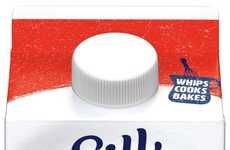
Researchers are Working on a Fat-Free Prototype of Whipped Creams
References: food.ku.dk & designtaxi
The researchers at the University of Copenhagen are working on a new fat-free whipped cream prototype for those to enjoy with their desserts. To do so, it uses bacteria as the base instead of the traditional milk fat to possibly create a more sustainable iteration of the goods.
The team works towards a more eco-friendly approach with the main challenge of baking the ingredients. It is difficult to achieve the right texture due to the smooth and light nature of whipped cream, whilst ensuring it is stiff enough to hold the shape of desserts as well. Researchers use lactic acid, which can be defined as a 'good bacteria' with the possibility of creating new products as a renewable source as well.
Image Credit: University of Copenhagen
The team works towards a more eco-friendly approach with the main challenge of baking the ingredients. It is difficult to achieve the right texture due to the smooth and light nature of whipped cream, whilst ensuring it is stiff enough to hold the shape of desserts as well. Researchers use lactic acid, which can be defined as a 'good bacteria' with the possibility of creating new products as a renewable source as well.
Image Credit: University of Copenhagen
Trend Themes
1. Fat-free Desserts - There's an opportunity to create more fat-free dessert options using new ingredients.
2. Bacteria-based Foods - The use of bacteria as a base for food production can lead to more sustainable and eco-friendly products.
3. Lactic Acid-based Products - Lactic acid, as a renewable source, can offer new opportunities for creating innovative food products.
Industry Implications
1. Food Manufacturing - Food manufacturers can explore the use of bacteria and lactic acid as a base for creating new products.
2. Dessert Industry - The dessert industry can benefit from creating more fat-free options using innovative ingredients.
3. Sustainability Industry - There's an opportunity to create more sustainable food products using bacteria and lactic acid as renewable sources.
3.2
Score
Popularity
Activity
Freshness























